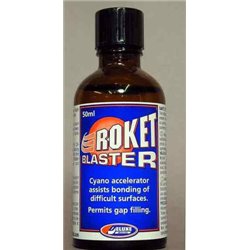Static grass puffer bottles work by manually charging model grass fibres with static electricity. When the charged...
No products
Product successfully added to your shopping cart
There are 0 items in your cart. There is 1 item in your cart.
Search Tips
What is a superglue activator?
A superglue activator, also known as a cyanoacrylate (CA) accelerator, is a chemical agent designed to speed up the curing process of superglue. Superglue itself, which is a cyanoacrylate adhesive, usually requires moisture in the air or on the bonding surfaces to polymerise and set. However, this process can sometimes take longer than desired, especially when working with materials that are less porous or in environments with low humidity. The activator triggers an almost instantaneous hardening of the adhesive, making it invaluable for certain applications, particularly in precision work such as modelling.
The use of superglue is common for bonding small or intricate parts made from materials like plastic, resin or metal. For instance, when assembling a finely detailed aircraft model, you might need to attach tiny photo-etched brass components to the fuselage. Applying a drop of superglue to the part and then spraying or brushing on an activator can ensure the bond is set immediately, preventing the piece from shifting out of alignment. This instant setting is particularly helpful when working with fragile or oddly shaped components that can be tricky to hold steady.
One of the key benefits of using a superglue activator is the time saved. Without an activator, you might have to hold parts together for several seconds or even minutes, depending on the glue and material. For larger projects, this waiting time can add up significantly. With an activator, the adhesive cures almost instantly, allowing you to move quickly onto the next step in your assembly or detailing work. This is especially advantageous when assembling models with numerous small components, such as a detailed 1/350 scale ship or a 1/72 scale military vehicle.
Another advantage is the strength and precision of the bond. When the activator is applied, it ensures the superglue cures evenly and rapidly, reducing the chance of the adhesive running or spreading to unwanted areas. This is particularly useful in scale modelling, where excess glue can mar the finish or obscure fine details. For example, when attaching delicate railings to a ship model, using a small amount of superglue combined with an activator ensures the bond is clean and precise, without excess glue oozing out.
That said, there are some considerations to keep in mind when using a superglue activator. The chemical reaction can sometimes generate heat, which might damage delicate materials like thin plastics or painted surfaces. Additionally, the accelerated curing process can make the glue more brittle, which might not be ideal for parts subjected to stress or movement. Therefore, it’s best to use the activator sparingly and only in situations where immediate curing is necessary.
Superglue activators are typically available in spray bottles or as brush-on liquids, making them easy to apply. For modelling, the spray form is particularly popular, as it allows even coverage without disturbing the delicate parts being glued. For example, after placing a tiny resin accessory on a tank model, a modeller might lightly spray activator over the area to lock the piece in place. This ensures a firm bond without requiring direct contact, which could risk knocking the part out of position.
In conclusion, a superglue activator is an indispensable tool for many modellers, helping to achieve clean, strong and quick bonds for small and intricate components. Whether you’re attaching photo-etched details, resin parts, or other challenging materials, the activator streamlines the process and enhances the precision of your work. However, like all tools, it requires careful use to avoid unintended effects, ensuring your models are both durable and beautifully detailed.
Click here to receive the tips weekly in your mailbox. You can unsubscribe at any time.








